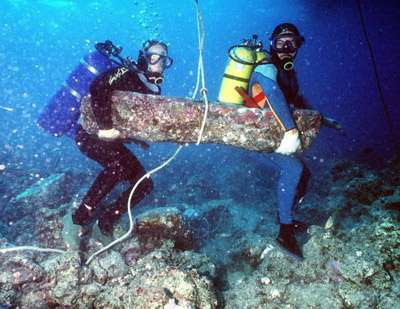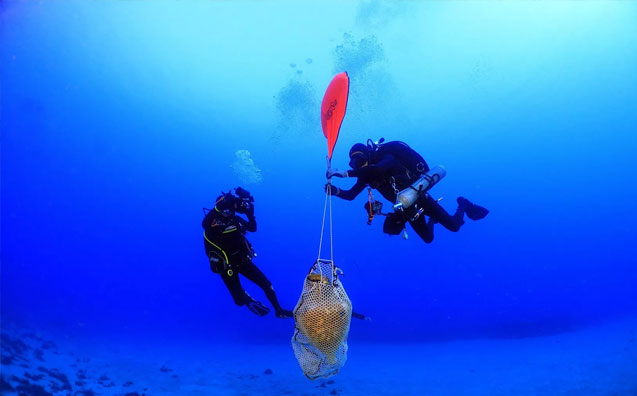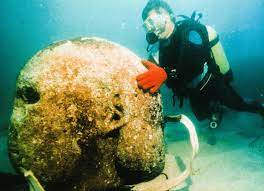Recreational Diving and Archaeology: Discover the Best Shipwrecks
Recreational diving and underwater archaeology are two thrilling activities that have captivated adventure seekers and history enthusiasts alike. The allure of exploring the depths of the ocean and uncovering ancient artifacts holds an irresistible appeal. One fascinating aspect of this combination is the exploration of shipwrecks, which offers a unique window into our maritime past.
Table of Contents
Excitement and Allure
The excitement of recreational diving lies in the sense of weightlessness and freedom as one navigates through the underwater world. The breathtaking beauty of vibrant coral reefs and diverse marine life creates a captivating environment for divers. However, when coupled with underwater archaeology, this experience becomes truly extraordinary. Imagine descending into the mysterious abyss, discovering a shipwreck that has been untouched for centuries, and unraveling the stories hidden within its rusted iron and decaying wood.
Discovering Shipwrecks
Shipwrecks carry immense historical and cultural significance. They are tangible links to our past, offering a glimpse into the lives of those who sailed the seas long ago. Exploring shipwrecks allows us to learn about maritime trade routes, naval battles, and technological advancements of bygone eras. These underwater treasures provide invaluable insights that shape our understanding of history.
Preserving and Studying Shipwrecks
Preserving and studying shipwrecks is crucial to safeguarding our maritime heritage. These underwater time capsules are delicate, and their preservation requires careful consideration. By studying shipwrecks, researchers can not only gain a deeper understanding of our past, but also contribute to ongoing conservation efforts. It is essential to document and analyze shipwrecks using modern techniques such as 3D scanning and mapping, ensuring that their stories are preserved for future generations.
Diving into the world of recreational diving and underwater archaeology is an awe-inspiring endeavor. With each dive, you have the opportunity to unearth hidden treasures and contribute to the preservation of our maritime history. So, immerse yourself in the excitement and allure of shipwreck exploration and embark on a journey that unveils the secrets of our past, all beneath the waves.
Importance of Shipwrecks
Shipwrecks hold immense historical and cultural significance, acting as tangible connections to our maritime past. These underwater time capsules provide a unique window into the stories of sailors, traders, and explorers who once lived and traveled across the seas. By studying shipwrecks, archaeologists can piece together the puzzle of our collective history and gain insights into ancient civilizations, trade routes, and technological advancements.
Preserving and studying shipwrecks is essential for understanding and appreciating the richness of our maritime heritage. These submerged treasures hold valuable artifacts, such as ceramics, navigation instruments, and even personal belongings, that give us glimpses into the daily lives of individuals from centuries ago. They also provide evidence of historic events, naval battles, and cultural exchanges, shedding light on the development of societies and the interconnectedness of different regions.
Furthermore, shipwrecks can contribute to our understanding of maritime archaeology. By exploring these underwater sites, researchers can refine their techniques, uncover new methods of analysis, and engage in interdisciplinary collaboration. This knowledge not only enhances our understanding of the past but also drives innovation in archaeological preservation and conservation techniques.
Preserving these underwater treasures is of utmost importance. Shipwrecks are delicate environments that require careful management and protection. By employing sustainable practices, such as non-invasive excavation methods and proper artifact conservation, we can ensure the long-term preservation of these historical sites. This preservation effort allows future generations to continue learning from and appreciating the significance of shipwrecks.
In conclusion, shipwrecks are not just remnants of unfortunate accidents at sea; they are portals to our maritime past. The historical and cultural significance of these submerged treasures, alongside their role in advancing our understanding of history and archaeology, makes their preservation and study imperative. By exploring shipwrecks and delving into their stories, we can unlock the mysteries of our past and truly appreciate the allure of uncovering history beneath the waves.
Popular Shipwreck Sites
There are several renowned shipwreck sites around the world that attract recreational divers and underwater archaeologists alike. These underwater treasures provide a glimpse into our maritime past and offer a unique and thrilling diving experience. Let’s explore some of these popular shipwreck sites and their notable features.
Great Barrier Reef
The Great Barrier Reef in Australia is not only famous for its stunning coral reefs but also for its shipwrecks. One of the most notable wrecks is the SS Yongala, which sank in 1911 and now serves as an artificial reef teeming with marine life. Diving at the Great Barrier Reef offers divers the opportunity to explore vibrant coral gardens and encounter a variety of marine species.
Red Sea
The Red Sea is another captivating destination for shipwreck enthusiasts. One of the most iconic wrecks in this region is the SS Thistlegorm, a British merchant ship that sank during World War II. This well-preserved wreck is now home to an abundance of marine life, including barracudas and colorful coral formations. Divers can also explore other wrecks such as the Dunraven and the Giannis D.
Bermuda Triangle
The mysterious Bermuda Triangle is not only associated with disappearances but also harbors a number of fascinating shipwrecks. One such wreck is the SS Marine Electric, a cargo ship that sank in 1983. This site, known as the “Ghost Ship,” offers divers a haunting experience as they discover the remnants of the vessel. Other notable wrecks in the area include the Cristobal Colon and the Constellation.
These shipwreck sites attract divers from all over the world due to their unique features and intriguing histories. Exploring these underwater time capsules allows divers to witness firsthand the impact of human history on the ocean’s depths. Whether you are an avid wreck diver or an aspiring underwater archaeologist, these sites offer an unforgettable experience and a chance to connect with our maritime heritage. So grab your diving gear and embark on a thrilling adventure to discover the best shipwrecks the world has to offer!
Technical Aspects of Recreational Diving and Archaeology
When it comes to recreational diving and archaeology, it is crucial to have the necessary skills and certifications in order to embark on underwater expeditions and explore shipwrecks. Diving in these unique environments requires expertise in navigating through underwater structures and handling potentially delicate artifacts.
Before venturing into this exciting world, it is important to obtain certifications such as Open Water Diver or Advanced Open Water Diver, which provide the necessary training and knowledge for safe recreational diving. These certifications cover topics such as buoyancy control, navigation, and dealing with potential underwater hazards. For those interested in underwater archaeology, additional certifications such as Underwater Archaeology Technician can further enhance one’s skills in documenting and studying submerged cultural heritage.
The equipment and tools required for exploring shipwrecks depend on the specific dive site and the nature of the expedition. Essential diving gear includes mask, snorkel, fins, regulator, buoyancy control device (BCD), and a dive computer for monitoring depth and bottom time. In shipwreck environments, additional equipment like flashlights, dive knives, reels, and underwater cameras may be necessary. These tools help divers navigate through confined spaces, capture images, and document significant findings. It is crucial to have a thorough understanding of the equipment and practice proper maintenance to ensure a safe and successful dive.
In any form of diving, safety protocols are of utmost importance. When exploring shipwrecks, it is essential to be aware of potential hazards such as sharp metal objects, entanglement risks, and limited visibility. Respecting the artifacts is also crucial to preserve the historical value of the site. Divers should avoid touching or removing any objects and maintain a proper distance to prevent accidental damage. Following established protocols and guidelines for shipwreck exploration helps protect both the divers and the archaeological remains, ensuring their preservation for future generations.
By acquiring the necessary skills and certifications, understanding the equipment and tools required, and adhering to safety protocols, recreational divers can embark on unforgettable adventures exploring the fascinating world of shipwrecks and underwater archaeology. The combination of thrill, historical exploration, and preservation efforts make these journeys truly unique. So dive in, discover the wonders beneath the waves, and be a part of preserving our maritime heritage for generations to come.
Shipwreck Dive Tips and Precautions
When embarking on a shipwreck exploration adventure, it is crucial to follow essential dive tips and precautions that are specific to this type of diving. Shipwrecks, although alluring and fascinating, present certain challenges and potential hazards that divers need to be aware of.
First and foremost, it is essential to respect the environment and the shipwreck itself. These underwater treasures are fragile and can be easily damaged or disturbed. Divers should exercise caution and avoid touching or removing any artifacts to preserve the site for future generations.
Proper buoyancy control is another crucial aspect of shipwreck diving. Maintaining neutral buoyancy allows divers to navigate through tight spaces and explore the wreckage without causing damage. It is essential to practice buoyancy control techniques and to be mindful of one’s movements to avoid accidental collisions with fragile structures.
In addition to respecting the environment and maintaining proper buoyancy, divers must also be aware of potential hazards associated with shipwreck exploration. These hazards can include sharp edges, entanglement hazards, and limited visibility. It is important to take necessary precautions, such as wearing appropriate dive gear and using a dive light to enhance visibility.
Diving within personal limits and seeking professional guidance is paramount to ensure safety during shipwreck exploration. It is recommended that divers have the necessary certification and experience to undertake these dives. Seeking guidance from experienced dive professionals can provide valuable insights and ensure a safe and rewarding exploration.
In conclusion, shipwreck diving offers a unique and thrilling experience for adventurous divers. However, it requires a certain level of knowledge and caution. By following these dive tips and precautions, respecting the environment, maintaining proper buoyancy, and seeking professional guidance, divers can enjoy the excitement of exploring shipwrecks while preserving these underwater treasures for generations to come. So remember, embrace the adventure, but do it responsibly!
Experiences and Discoveries
Diving into the depths of the ocean, enthusiasts of recreational diving and archaeology have uncovered a world of incredible experiences and remarkable discoveries. These individuals have bravely ventured into shipwreck sites, delving into the mysteries hidden beneath the waves. During their expeditions, they have encountered fascinating stories and made noteworthy archaeological findings, shedding new light on history and our maritime heritage.
One such tale involves a group of divers exploring a shipwreck off the coast of Greece. As they descended into the depths, they discovered a treasure trove of artifacts, including ancient pottery, coins, and even a beautifully preserved anchor. These artifacts provided valuable insights into the trade routes and seafaring practices of the ancient Greeks. Their discovery not only captivated the imagination of archaeologists, but also enriched our understanding of the past.
Another remarkable experience took place in the waters of the Caribbean. A team of recreational divers stumbled upon a well-preserved shipwreck dating back to the 17th century. As they explored the wreckage, they unearthed a collection of cannons, navigational instruments, and personal belongings of the crew. These findings not only offered a glimpse into the lives of sailors during that era but also provided important clues about the historical events that transpired at the time.
The impact of these discoveries cannot be underestimated. Through recreational diving and archaeological expeditions, we have been able to piece together fragments of history that were once lost to the depths. These findings have breathed life into the stories of those who sailed these ships, enabling us to connect with our maritime heritage in a profound and tangible way. They have also sparked renewed interest in preserving these underwater treasures, ensuring that future generations can continue to explore and learn from them.
In conclusion, the experiences and discoveries made during recreational diving and archaeology expeditions at shipwreck sites are nothing short of awe-inspiring. These brave explorers have unearthed artifacts, shared stories, and shed light on the past, enriching our understanding of history and our maritime heritage. As we continue to delve into the depths, it is essential that we approach these sites with respect and reverence, recognizing the significance of our discoveries and the importance of preserving these underwater time capsules. So, get ready to embark on an extraordinary adventure beneath the waves, for the allure of uncovering history submerged in the deep blue sea awaits.
Future Preservation and Exploration Efforts
As we delve into the world of recreational diving and underwater archaeology, it is crucial to consider the future preservation and exploration efforts focused on shipwrecks. These underwater treasures not only provide a glimpse into our maritime past but also hold immense historical and cultural significance.
Ongoing efforts are being made to preserve shipwrecks and protect their associated artifacts. Organizations and institutions dedicated to underwater archaeology work tirelessly to document and study these wrecks, ensuring their preservation for future generations. By utilizing advanced technology such as 3D scanning and mapping, researchers can create detailed digital models of the wrecks, preserving them in a virtual realm while also allowing for in-depth analysis.
The role of technology in documenting and studying shipwrecks cannot be understated. 3D scanning provides an accurate representation of the wrecks, capturing every intricate detail. This technology helps archaeologists study the wrecks without physically disturbing them, thus preserving their fragile state. Mapping techniques allow researchers to create comprehensive visual representations of the wrecks’ surroundings, aiding in understanding their historical context.
Looking ahead, there are exciting upcoming exploratory projects aimed at discovering new shipwrecks. The adventurous combination of recreational diving and archaeology continues to attract explorers and enthusiasts from around the world. These future expeditions hold the promise of uncovering hidden secrets and untold stories from beneath the waves.
In conclusion, ongoing efforts to preserve shipwrecks and their associated artifacts are crucial for maintaining and expanding our knowledge of history and maritime heritage. By harnessing the power of technology and embarking on new exploratory projects, we can continue to unravel the mysteries and uncover the wonders of the underwater world. Let us embrace the allure of shipwrecks and contribute to their preservation, knowing that each dive could be an opportunity to make meaningful discoveries and connect with our past.
Conclusion
Recreational diving and archaeology offer an exhilarating combination of adventure and exploration. By diving into the depths of the ocean, we have the opportunity to uncover the secrets of shipwrecks and delve into our maritime past. The importance of shipwrecks cannot be understated, as they provide a valuable glimpse into history and culture. Preserving and studying these underwater treasures is crucial for our understanding of the past.
Around the world, there are numerous renowned shipwreck sites that beckon adventurous divers. From the majestic Great Barrier Reef to the mysterious Bermuda Triangle, each site has its own unique features and notable shipwrecks. These sites attract divers and archaeologists alike, offering a chance to witness history firsthand.
However, recreational diving and archaeology require certain skills and certifications. It is essential to be equipped with the necessary training and knowledge to ensure a safe and successful dive. Diving and archaeological equipment, such as dive computers and underwater cameras, are also vital for exploration. Moreover, safety protocols must be followed to preserve the integrity of shipwrecks and their artifacts.
When embarking on a shipwreck dive, there are specific tips and precautions to keep in mind. Respecting the environment, maintaining proper buoyancy control, and being aware of potential hazards are all crucial aspects. It is imperative to dive within personal limits and seek professional guidance to ensure a fulfilling and safe experience.
Recreational divers and archaeologists have made fascinating discoveries and contributed to our understanding of history and maritime heritage. Noteworthy archaeological findings have been made during underwater expeditions, shedding light on ancient civilizations and historical events. These discoveries have fueled our curiosity and deepened our appreciation for the hidden treasures beneath the waves.
Looking ahead, preserving shipwrecks and their associated artifacts remains a priority. Ongoing efforts, coupled with the advances in technology, such as 3D scanning and mapping, play a significant role in documenting and studying wrecks. Furthermore, upcoming exploratory projects aim to uncover new shipwrecks and further enrich our knowledge of the past.
In conclusion, the combination of recreational diving and archaeology opens up a world of excitement and adventure. It offers an opportunity to explore the incredible wonders of shipwrecks and contribute to their preservation. The allure of uncovering history beneath the waves is irresistible, and we invite readers to take the plunge and discover the captivating world of underwater archaeology.







